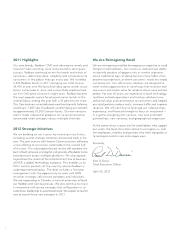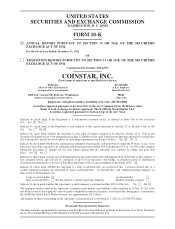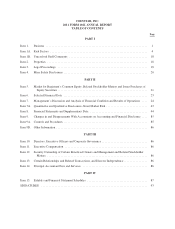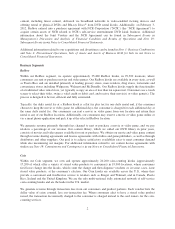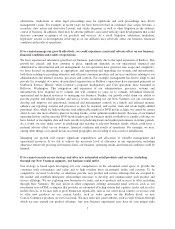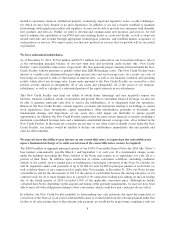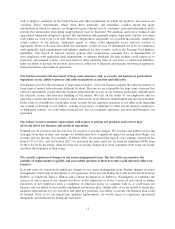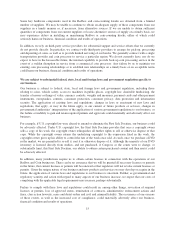Redbox 2011 Annual Report Download - page 13
Download and view the complete annual report
Please find page 13 of the 2011 Redbox annual report below. You can navigate through the pages in the report by either clicking on the pages listed below, or by using the keyword search tool below to find specific information within the annual report.bonus content or other features on certain sell-through DVDs that are not included on DVDs made
available for rent, increased focus on digital sales, or movie content failing to appeal to consumers’
tastes.
• The risks described below in “—Our inability to receive delivery of DVDs on the date of their initial
release to the general public, or shortly thereafter, for home entertainment viewing could adversely
affect our Redbox business” and “—If we do not manage our DVD inventory effectively, our business,
financial condition and results of operations could be materially and adversely affected.”
• Decreased costs for consumers to purchase or receive movie content, including less expensive DVDs,
more aggressive competitor pricing strategies and piracy.
Adverse developments relating to any of these risks, as well as others relating to our participation in the home
video industry, could significantly affect our business, financial condition and operating results.
Our inability to receive delivery of DVDs on the date of their initial release to the general public, or shortly
thereafter, for home entertainment viewing could adversely affect our Redbox business.
Traditionally, businesses that rent movies in physical formats, such as DVDs, have enjoyed a competitive
advantage over other movie distribution rental channels because of earlier timing of the distribution window for
physical formats by movie studios. After the initial theatrical release of a movie, the major studios generally have
made their movies available on physical formats for a 30- to 45-day release window before release to other
movie distribution rental channels, such as pay-per view, video-on-demand, premium television, basic cable, and
network and syndicated television. Increasingly, however, major studios have experimented with compressing
the window between DVD and video-on-demand release or with releasing movies in each channel
simultaneously and in some cases, before they are available for rent. Additionally, in some cases, major studios
have staggered releases of DVDs such that a movie might be less available or unavailable for rental for weeks
after the DVD becomes available for purchase at a retail outlet or is available by video-on-demand.
However, certain movie studios have changed or are changing and other movie studios could change their
practices, including shortening or discontinuing altogether, or otherwise restricting, movie distribution windows,
including simultaneous video-on-demand/digital downloads/online streaming and DVD releases or making
video-on-demand/digital downloads/online streaming available prior to DVD release. For example, certain movie
studios have made new release titles available on video-on-demand or for online purchase on the same date as the
DVD release, and that certain movies will be made available via premium video-on-demand while they are still
in theaters. Further, certain studios have implemented or announced their intention to implement policies to
lengthen the time that certain video retailers, including those providing movies on physical formats, must wait
before renting movies following their initial release on DVD to retailers. For example, Redbox has entered into
arrangements with certain studios that include delayed rental windows. Entering into these studio licensing
arrangements that contain a delayed rental window may decrease consumer satisfaction and consumer demand,
and we may lose consumers to our competitors that offer DVD titles without a delayed rental window. Any of
these developments could have a material adverse effect on our business, financial condition and results of
operations. For example, we believe that the 28-day delayed rental window of certain of our DVD titles during
the holiday season negatively impacted our fourth quarter 2010 rental and financial results.
If we do not manage our DVD inventory effectively, our business, financial condition and results of
operations could be materially and adversely affected.
A critical element of our Redbox business model is to optimize our inventory of DVD titles, formats, and copy
depth to achieve satisfactory availability rates to meet consumer demand while also maximizing margins. If we
do not timely acquire sufficient DVD titles, due to, for example, not correctly anticipating demand, intentionally
acquiring fewer copies than needed to fully satisfy demand or the lack of available titles, we may not
appropriately satisfy consumer demand, which could decrease consumer satisfaction and we could lose
5


